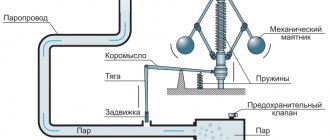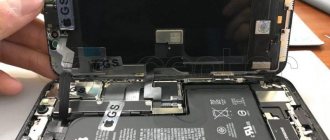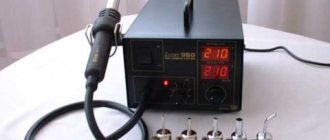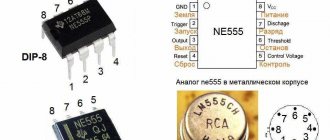Just twenty-five years ago, radio amateurs and older generation specialists had to study new devices at that time - transistors. It was not easy to give up the vacuum tubes that we were so accustomed to and switch to the crowding and ever-expanding “family” of semiconductor devices.
And now this “family” has increasingly begun to give way in radio engineering and electronics to the latest generation of semiconductor devices - integrated circuits, often called ICs for short.
What is an integrated circuit
An integrated circuit is a miniature electronic unit containing in a common housing transistors, diodes, resistors and other active and passive elements, the number of which can reach several tens of thousands.
One microcircuit can replace an entire unit of a radio receiver, an electronic computer (computer) and an electronic machine. The “mechanism” of a digital wristwatch, for example, is just one larger chip.
According to their functional purpose, integrated circuits are divided into two main groups: analog, or linear-pulse, and logical, or digital, microcircuits.
Analog microcircuits are intended for amplification, generation and conversion of electrical oscillations of different frequencies, for example, for receivers, amplifiers, and logical ones - for use in automation devices, in devices with digital timekeeping, in computers.
This workshop is devoted to familiarization with the device, operating principle and possible application of the simplest analog and logical integrated circuits.
What are Logic Integrated Circuits (ICs)
Essentially, this is a microelectronic device that is based on a crystal of arbitrary complexity, which is made on a semiconductor film or wafer. It is placed in a non-separable case (although it can do without it, but only when it is part of a microassembly). The first integrated circuit was patented in 1968. This was a kind of breakthrough in the industry, although the provided device did not very much correspond to modern ideas in its parameters. Integrated circuits are mostly manufactured for surface mounting. Often, IC is understood as just one crystal or film. The most widespread is the integrated circuit on a silicon wafer. It so happens that its use in industry has a number of advantages, for example, the efficiency of signal transmission.
On an analog chip
Of the huge “family” of analogue ones, the simplest are the twin microcircuits K118UN1A (K1US181A) and K118UN1B (K1US181B), which are part of the K118 series.
Each of them is an amplifier containing... However, it’s better to talk about the electronic “stuffing” later. For now, we will consider them “black boxes” with pins for connecting power supplies, additional parts, input and output circuits to them.
The difference between them lies only in their amplification factors for low-frequency oscillations: the gain factor of the K118UN1A microcircuit at a frequency of 12 kHz is 250, and the K118UN1B microcircuit is 400.
Rice. 1. Microcircuit and circuit based on it.
At high frequencies, the gain of these microcircuits is the same - approximately 50. So, any of them can be used to amplify oscillations of both low and high frequencies, and therefore for our experiments. The appearance and symbols of these amplifier microcircuits on the circuit diagrams of the devices are shown in Fig. 1.
They have a rectangular plastic body. On the top of the case there is a mark that serves as a reference point for the pin numbers. The microcircuits are designed for power from a DC source with a voltage of 6.3 V, which is supplied through pins 7 (+Upit) and 14 (- Upit).
The power source can be an AC power supply with adjustable output voltage or a battery made up of four cells 334 and 343.
The first experiment with the K118UN1A (or K118UN1B) microcircuit was carried out according to the diagram shown in Fig. 89. As a mounting board, use a cardboard plate measuring approximately 50X40 mm.
Solder the microcircuit with pins 1, 7, 8 and 14 to wire brackets passed through punctures in the cardboard. All of them will serve as racks holding the microcircuit on the board, and the brackets of pins 7. and 14, in addition, will serve as connecting contacts with the GB1 battery (or the mains power supply).
Between them, on both sides of the microcircuit, strengthen two or three more contacts, which will be intermediate for additional parts. Mount capacitors C1 (type K50-6 or K50-3) and C2 (KYAS, BM, MBM) on the board, connect headphones B2 to the output of the microcircuit.
Connect (via capacitor C1) an electrodynamic microphone B1 of any type or a DEM-4m telephone capsule to the input of the microcircuit, turn on the power and, pressing the phones more tightly to your ears, tap lightly on the microphone with a pencil. If there are no errors in the installation, sounds resembling clicks on a drum should be heard in the phones.
Ask a friend to say something in front of the microphone - you will hear his voice on the phones. Instead of a microphone, you can connect a radio broadcast (subscriber) loudspeaker with its matching transformer to the input of the microcircuit. The effect will be about the same.
Continuing the experiment with a single-acting telephone device, connect between the common (negative) conductor of the power circuit and pin 12 of the microcircuit the electrolytic capacitor C3, indicated in the diagram by dashed lines. At the same time, the sound volume on phones should increase.
Telephones will sound even louder if the same capacitor is connected to pin 5 (in Fig. 1 - capacitor C4). But if the amplifier is excited, then between the common wire and pin 11 you will have to connect an electrolytic capacitor with a capacity of 5 - 10 µF. nominal voltage 10 V.
Another experiment: connect a ceramic or paper capacitor with a capacity of 5 - 10 thousand picofarads between pins 10 and 3 of the microcircuit. What happened? An incessant medium-pitched sound appeared on phones. As the capacitance of this capacitor increases, the sound tone in telephones should decrease, and with decrease, it should increase. Check this.
Rice. 2. Internal circuit of the microcircuit.
Now let’s open this “black box” and look at its “filling” (Fig. 2). Yes, this is a two-stage amplifier with direct coupling between its transistors. Silicon transistors, n-p-n structures. The low-frequency signal generated by the microphone is supplied (via capacitor C1) to the input of the microcircuit (pin 3).
The voltage drop created across resistor R6 in the emitter circuit of transistor V2 is supplied through resistors R4 and R5 to the base of transistor VI and opens it. Resistor R1 is the load of this transistor. The amplified signal taken from it goes to the base of transistor V2 for additional amplification.
In the experimental amplifier, the load of transistor V2 was headphones included in its collector circuit, which converted the low-frequency signal into sound.
But its load could be resistor R5 of the microcircuit if pins 10 and 9 are connected together. In this case, the telephones must be connected between the common wire and the connection point of these pins through an electrolytic capacitor with a capacity of several microfarads (the positive plate to the microcircuit).
When the capacitor was connected between the common wire and pin 12 of the microcircuit, the sound volume increased. Why? Because, by shunting resistor R6 of the microcircuit, he weakened the negative alternating current feedback operating in it.
The negative feedback became even weaker when you connected the second capacitor to the base circuit of transistor V1. And the third capacitor, connected between the common wire and pin 11, formed an decoupling filter with resistor R7 of the microcircuit, preventing excitation of the amplifier.
What happened when you connected a capacitor between pins 10 and 5? He created a positive feedback between the output and input of the amplifier, which turned it into an audio frequency oscillator.
So, as you can see, the K118UN1B (or K118UN1A) microcircuit is an amplifier that can be low-frequency or high-frequency, for example, in a receiver. But it can also become a generator of electrical oscillations of both low and high frequencies.
A Brief History of Microchip Creation
In 1958, an American engineer named Jack Kilby showed the first version of the chip to his superiors. While the rest of the employees were on vacation, he worked to simplify this device. The first such products had a large mass and impressive dimensions. They were made sloppily, unlike modern models.
Electrical circuit parts were built onto a germanium plate. They converted direct current to alternating current. No solder was used to connect the blocks. Suspended metal wires were used for this purpose. But the developer was awarded the Nobel Prize only in 200.
Microcircuit in a radio receiver
We propose to test this microcircuit in the high-frequency path of a receiver assembled, for example, according to the circuit shown in Fig. 3. The input circuit of the magnetic antenna of such a receiver is formed by coil L1 and variable capacitor C1. The high-frequency signal of the radio station to which the circuit is tuned is sent through the coupling coil L2 and the separating capacitor C2 to the input (pin 3) of the L1 microcircuit.
From the output of the microcircuit (pin 10, connected to pin 9), the amplified signal is fed through capacitor C4 to the detector, diodes VI and V2 of which are connected according to the voltage multiplication circuit, and the low-frequency signal allocated to it is converted into sound by phones B1. The receiver is powered by a GB1 battery, composed of four 332, 316 cells or five D-01 batteries.
Rice. 3. Receiver circuit on a microcircuit.
In many transistor receivers, the high-frequency amplifier is formed by transistors, but in this one it is a microcircuit. This is the only difference between them.
Having the experience of previous workshops, I hope you will be able to independently mount and set up such a receiver and even, if you wish, supplement it with a low-frequency amplifier for loud-speaking radio reception.
Brief historical background.
The first experiments in creating semiconductor integrated circuits were carried out in 1953, and industrial production of integrated circuits began in 1959. In 1966, production of integrated circuits of medium degree of integration began (the number of elements in one crystal is up to 1000). In 1969, integrated circuits with a higher degree of integration (large-scale integrated circuits, LSI) were created, containing up to 10,000 elements in one chip.
Vasiliev Dmitry Petrovich
Professor of Electrical Engineering, St. Petersburg State Polytechnic University
Ask a Question
In 1971, microprocessors were developed, and in 1975, very-large-scale integrated circuits (VLSI), containing more than 10,000 elements in a single chip. It is useful to note that the limiting frequency of bipolar transistors in semiconductor integrated circuits reaches 15 GHz or more.
By 2000, integrated circuits are expected to appear containing up to 100 million MOS transistors in a single chip (we are talking about digital circuits).
On a logic chip
An integral part of many digital integrated circuits is the AND-NOT logical element, the symbol of which you see in Fig. 4, a. Its symbol is the "&" sign placed inside a rectangle, usually in the upper left corner, replacing the conjunction "AND" in English. There are two or more inputs on the left, one output on the right.
The small circle that begins the communication line of the output signal symbolizes the logical Negation “NOT” at the output of the microcircuit. In the language of digital technology, “NOT” means that the NAND element is an inverter, that is, a device whose output parameters are opposite to the input ones.
The electrical state and operation of a logic element are characterized by the signal levels at its inputs and output. A small (or zero) voltage signal, the level of which does not exceed 0.3 - 0.4 V, is usually called (in accordance with the binary number system) logical zero (0), and a higher voltage signal (compared to logical 0), the level of which can be 2.5 - 3.5 V, - logical unit (1).
For example, they say: “the output of the element is logical 1.” This means that at the moment a signal has appeared at the output of the element, the voltage of which corresponds to the logical level 1.
In order not to delve into the technology and structure of the NAND element, we will consider it as a “black box”, which has two inputs and one output for an electrical signal.
The logic of the element is that when logical O is applied to one of its inputs, and logical 1 is applied to the second input, a logical 1 signal appears at the output, which disappears when signals corresponding to logical 1 are applied to both inputs.
For experiments that memorize this property of the element, you will need the most common K155LAZ microcircuit, a DC voltmeter, a fresh 3336L battery and two resistors with a resistance of 1...1.2 kOhm.
Rice. 4. Logical elements of the K155LAZ microcircuit.
The K155LAZ microcircuit consists of four 2I-NOT elements (Fig. 4, b), powered by one common DC source of 5 V, but each of them operates as an independent logical device. The number 2 in the name of the microcircuit indicates that its elements have two inputs.
In appearance and design, it, like all microcircuits of the K155 series, does not differ from the already familiar analog microcircuit K118UN1, only the polarity of connecting the power source is different. Therefore, the cardboard board you made earlier is suitable for experiments with this microcircuit. The power source is connected: +5 V - to pin 7" - 5 V - to pin 14.
But these conclusions are not usually indicated on a schematic diagram of the microcircuit. This is explained by the fact that on circuit diagrams the elements that make up the microcircuit are depicted separately, for example, as in Fig. 4, c. For experiments, you can use any of its four elements.
Solder the microcircuit with pins 1, 7, 8 and 14 to the wire stands on the cardboard board (as in Fig. 1). One of the input pins of any of its elements, for example, an element with pins 1 - 3, is connected through a resistor with a resistance of 1...1.2 kOhm to pin 14, the pin of the second input is directly connected to the common (“grounded”) conductor of the power circuit, and Connect a DC voltmeter to the output of the element (Fig. 5, a).
Turn on the power. What does the voltmeter show? A voltage of approximately 3 V. This voltage corresponds to a logic 1 signal at the output of the element. Using the same voltmeter, measure the voltage at the output of the first input. And here, as you can see, it is also logical 1. Therefore, when one of the inputs of the element is logical 1, and the second is logical 0, the output will be logical 1.
Rice. 5. Voltage measurements on a logic element.
Now connect the output of the second input through a resistor with a resistance of 1...1.2 kOhm to terminal 14 and at the same time with a wire jumper - with a common conductor, as shown in Fig. 5 B.
In this case, the output, as in the first experiment, will be logical 1. Next, watching the voltmeter needle, remove the jumper wire so that a signal corresponding to logical 1 is sent to the second input.
What does a voltmeter record? The signal at the output of the element is converted to logical 0. This is how it should be! And if any of the inputs are periodically shorted to a common wire and thereby simulate the supply of a logical 0 to it, then current pulses will appear at the output of the element with the same frequency, as evidenced by fluctuations in the voltmeter needle. Check this out experimentally.
The property of the NAND element to change its state under the influence of input control signals is widely used in various digital computing devices. Radio amateurs, especially beginners, very often use a logic element as an inverter - a device whose output signal is opposite to the input signal.
The following experiment can confirm this property of the element. Connect the terminals of both inputs of the element together and, through a resistor with a resistance of 1...1.2 kOhm, connect them to pin 14 (Fig. 5, c).
This way you will apply a signal corresponding to logical 1 to the common input of the element, the voltage of which can be measured with a voltmeter. What is the output?
The voltmeter needle connected to it slightly deviated from the zero scale mark. Here, therefore, as expected, the signal corresponds to logical 0.
Then, without disconnecting the resistor from pin 14 of the microcircuit, connect the input of the element to the common conductor with a wire jumper several times in a row (shown in Fig. 5, c by a dashed line with arrows) and at the same time watch the voltmeter arrow.
So you will be convinced that when the inverter input is logical 0, the output is logical 1 and, conversely, when the input is logical 1, the output is logical 0.
This is how an inverter works, especially often used by radio amateurs in the pulse devices they construct.
Rice. 6. Circuit diagram of an AF signal generator on a microcircuit.
An example of such a device is a pulse generator assembled according to the circuit shown in Fig. 6. You can verify its functionality right away, spending just a few minutes on it.
The output of element D1.1 is connected to the inputs of element D1.2 of the same microcircuit, its output is connected to the inputs of element DJ.3, and the output of this element (output
Set the variable resistor motor to the right (according to the diagram) position and turn on the power - you will hear a sound in the phones, the tone of which can be changed with a variable resistor.
In this experiment, elements D1.1, D1.2 and D1.3, connected in series, like transistors of a three-stage amplifier, formed a multivibrator - a generator of rectangular electrical pulses.
The microcircuit became a generator thanks to a capacitor and resistor, which created frequency-dependent feedback circuits between the output and input of the elements. Using a variable resistor, the frequency of the pulses generated by the multivibrator can be smoothly varied from approximately 300 Hz to 10 kHz.
What practical application can such a pulse device find? It can become, for example, an apartment bell, a probe for checking the performance of the receiver and low-frequency amplifier cascades, a generator for training in listening to the telegraph alphabet.
Main types of modern microcircuits
It is important to understand that progress does not stand still: every year the list of main types of microcircuits undergoes significant changes, in addition, their range is expanding.
The types of microcircuits are different, depending on the main evaluation criteria.
By purpose:
1. Digital. Necessary for processing a special signal expressed in digital code. They have a significant number of advantages over other types: lower costs for electricity consumption, in addition, they have greater resistance to interference.
Digital microcircuits are often used in various computers, such as automation systems, electronic computers and many others.
2. Analog. Designed for processing and converting continuously incoming signals. Analog chips have high performance. Often used in such popular devices as:
Video recorders.
Televisions.
Audio frequency converters.
In various voltage stabilizers.
In sensors.
Operational amplifiers.
3. Analog-digital. They are a true hybrid of the two microcircuits presented above. They are very popular due to their increased performance indicators; in addition, they combine the positive characteristics of two types of microcircuits at once. They are used to create most modern technology, such as:
Modulators and demodulators.
Switches.
Frequency generators and restorers.
By type of construction:
1. Film. These are microcircuits for the manufacture of which a special technique is used. In addition, all connecting elements are a special film layer. There are certain divisions into two types: thin-film and thick-film, differing in the thickness of the film layer.
2. Semiconductor chips are not used very often; they are made using plastic (usually epoxy resin) with special wire or tape leads that ensure the performance of the device.
3. Hybrid. More complex devices, for the manufacture of which not only popular films and substrates are used, but also less common attachment materials (for example, various crystals).
By body type:
1. Cabinet. With this type of design, the microcircuit is placed in a special case (the material from which it is made can be chosen by the manufacturer). This type is not particularly popular in everyday life. Most often, the microcircuit is placed in a housing in order to avoid breakage or deformation of individual parts during transportation.
Packaged microcircuits are used to transport large quantities of goods. In any other case, it is cheaper for the manufacturer to produce unpackaged microcircuits.
2. Unpackaged microcircuits. Most often, it is the open-frame models that are used. The microcircuit does not fit into the case; in this case, for protection, all parts are filled with special paint or compound. This is what allows you to protect the crystal from damage or any other negative environmental influences.
Such designs are produced specifically for installation in a hybrid circuit or preliminary microassembly.
When choosing a microcircuit, you should take into account all the advantages and disadvantages of the main types. Certain technical devices require certain microcircuits; in order to select the required model, it is necessary to obtain professional advice from specialists in this field. In this case, the device you choose will last a long time.










